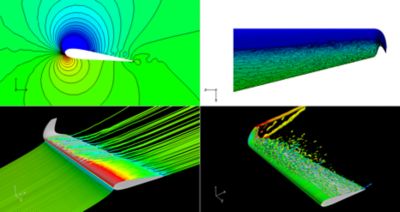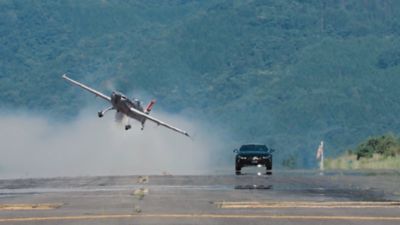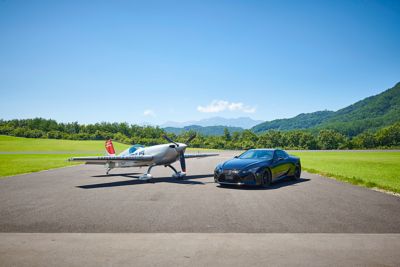-
United States -
United Kingdom -
India -
France -
Deutschland -
Italia -
日本 -
대한민국 -
中国 -
台灣
-
Ansysは、シミュレーションエンジニアリングソフトウェアを学生に無償で提供することで、未来を拓く学生たちの助けとなることを目指しています。
-
Ansysは、シミュレーションエンジニアリングソフトウェアを学生に無償で提供することで、未来を拓く学生たちの助けとなることを目指しています。
-
Ansysは、シミュレーションエンジニアリングソフトウェアを学生に無償で提供することで、未来を拓く学生たちの助けとなることを目指しています。
ANSYS ADVANTAGE MAGAZINE
DECEMBER 2021
Collaboration among engineers often leads to innovation, but engineers at Toyota Motor Corp. have extended their knowledge of automotive aerodynamics by working with an air racing team. The unusual collaboration employed simulation to improve both airplane and automobile aerodynamics.
Yusuke Nakae, in charge of R&D of CAE technology at Toyota Motor Corp., has been working with Ansys Channel Partner JSOL Corp. on fluid analysis using Ansys LS-DYNA to measure aerodynamic forces generated when a vehicle is in motion and how it affects vehicle stability. By using automotive simulation results to improve the air racing plane, and then learning from those results to improve Lexus vehicles, Nakae’s team has found analyses that wouldn’t have been possible using conventional methods.
FROM CONVENTIONAL TO EXPERIMENTAL AERODYNAMICS
The conventional method of testing vehicle aerodynamics involves applying wind to a car when it’s stationary and then measuring what changes via experiments and calculations. Wondering how the air forces would be different when the car was moving vs. when it was stationary inspired Nakae’s team to try to analyze a moving vehicle. Specifically, they wanted to simulate the aerodynamics of a car as it changed lanes using LS-DYNA.
The results obtained from normal analysis (where wind is applied when the car is stopped) were clearly different from the results when the car was driven. However, measuring the force of air when driving the car was still a challenge — even in a wind tunnel. Nakae’s team wanted to use simulations to quantitatively analyze the difference in aerodynamic forces. Because Toyota uses LS-DYNA as a standard tool for crash safety performance analysis, the team thought it could create an ideal environment for analyzing multiple physical properties with a single solver if they could add a fluid analysis function to it.
Lexus was sponsoring Yoshihide Muroya, who competes in the Red Bull Air Race World Championships. In 2017, Nakae’s team first tested their theory on airplane aerodynamics leading up to the race.

AIRPLANE AERODYNAMIC RESULTS BENEFIT CAR DESIGN
In the airplane world, aerodynamic analysis is usually done in a stationary state, so getting the air racing team to agree to applying the knowledge and expertise used in automotive simulations to airplane racing design was a challenge.
Part of the problem was the difference in air speed.
Airplanes are fast — propeller planes travel at 350 km per hour — while cars are slow, traveling at 100 km per hour. Moreover, airplanes are streamlined, but cars are not, so flows around their bodies are completely different. This means researchers couldn’t accurately calculate aerodynamic force unless they could reproduce their flow, especially in turbulent conditions.
Luckily, an abundance of experimental data on airplane wings already exists, so Nakae’s team could choose the right turbulence model for the airplane analysis.
Using different motions that would result in different aerodynamic forces, the team conducted simulations. High-performance computing was used to go through the complex calculations, compile the data, visualize it, and share it with the air racing team.
During air races, the team would test techniques, analyze the data they recorded and then test the updated techniques iteratively. A competitor even noticed that Muroya was flying in a bigger circle, yet their total time decreased.

AIR RACING RESULTS INSPIRE NEW LEXUS VEHICLE
Toyota/Lexus learned a lot from this experience.
“I learned how to control vortices, which should not be generated from the perspective of aerodynamic drag,” Nakae said. “I gained experience on how to control vortices by experimenting with different shapes of winglets and analyzing the simulation to find the one with the least aerodynamic drag.”
Turning to automobiles, the team knew that creating effective vortices around a car could improve its dynamic performance. And performance turned out to be as good as they hypothesized, leading to the release of the Lexus LC 500 Inspiration Series in January. This limited edition takes the 471-horsepower V8 grand-touring coupe to the next level. A big upgrade inspired by air racing is a carbon-fiber reinforced plastic rear spoiler modeled after an inverted aircraft wing with vortices at the wingtips that improve maneuverability and efficiency.

LOOKING TO THE FUTURE
While the Red Bull Air Race World Championships was deactivated in 2019, Nakae’s team will work to continue aerodynamic simulation research.
Looking at future automotive design, Toyota/Lexus will continue to use what they are learning by comparing the two different transportation methods and analyzing them to create new products.
As Nakae says, “Analysis technology enables us to realize methods and performance that overturn conventional wisdom.”
さあ、始めましょう
エンジニアリング課題に直面している場合は、当社のチームが支援します。豊富な経験と革新へのコミットメントを持つ当社に、ぜひご連絡ください。協力して、エンジニアリングの障害を成長と成功の機会に変えましょう。ぜひ今すぐお問い合わせください。










